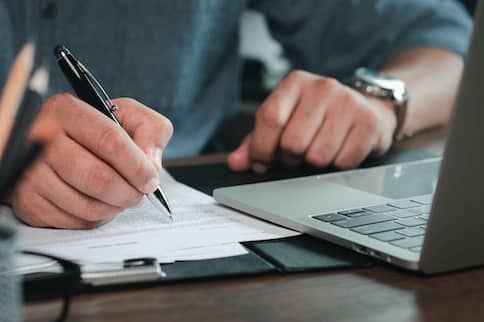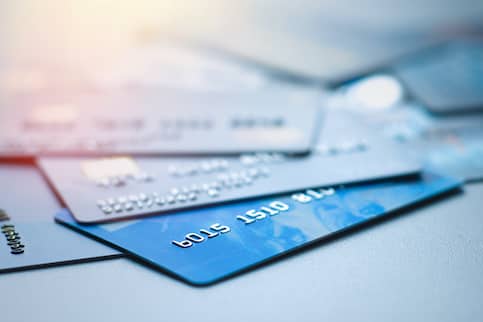How To Pay Off Credit Card Debt: A Complete Guide

A credit card provides a way to cover expenses you might not have the budget to pay for now but can pay back at a later date. Using a credit card is also a great way to build up your credit score, which is a required valuation for many of life’s big purchases – like a car or mortgage loan – because it shows your reliability as a borrower.
Unfortunately, actions like overspending or using a credit card to cover unexpected or emergency expenses can lead to credit card debt. While there isn’t a one-size-fits-all solution to getting out of credit card debt, some time-tested strategies can help reduce your credit burden and improve your financial well-being. The following common methods for paying down credit card debt may help you reach your financial goals.
What’s The Best Way To Pay Off Credit Card Debt?
There isn’t an easy or perfect solution for paying down credit card debt. Instead, it’s important to consider your goals for paying off your credit cards. In addition to completely eliminating the debt, ask yourself how you want to go about it. Do you want to pay it off quickly? Do you want to save money on interest charges? Do you want to target the balances on all of your credit cards at once?
Determining your goals for removing your credit debt can help you narrow down the best approach for your situation. Consider an option that helps you achieve your goals while also giving you the wiggle room to make your recurring monthly payments and contribute to a savings or emergency fund.
See What You Qualify For
Home Purchase
Home Refinance
Tap Into Equity
How To Pay Down Credit Card Debt: 7 Strategies To Consider
Tackling your credit card debt can seem like a daunting task, but it’s not impossible. Here are seven strategies to consider for paying down your credit card debt.
1. Pay Off The Smallest Balance
One way to lower your credit card debt is to focus on paying off the smallest credit card balance first. This strategy is called the snowball method because you start by eliminating the smallest debt and slowly move on to larger credit card balances until the payments snowball and you’re debt-free.
The goal of the snowball method is to pay off your credit card balances as quickly as possible. Rather than making several credit card payments all at once, this approach helps you zero in on one debt until it’s completely paid off. Keep in mind that you’ll still make the minimum payments on all other debts to avoid any late fees that could increase the card balances and hurt your credit score.
The benefit is that you may stay more motivated as you see more and more debt wiped away. However, the downside of the snowball method is that you could end up paying more money in the long run. If you’re focused on paying down a credit card with the smallest balance rather than a card with a larger balance or a higher interest rate, you could accrue more interest charges on the card you’re not working to pay off. If you want to pay down debt while also reducing your interest payments, another payment method may work better for you.
2. Pay Off The Highest Interest Rate
Another strategy for paying down your credit card debt involves first targeting the credit card with the highest interest rate. Also called the avalanche method, the goal of this approach is to pay off the highest-interest-rate credit card as soon as possible, before moving on to cards with lower interest rates or smaller balances.
At first, it may not seem like you’re making a lot of progress with the avalanche method – but it can help you save on interest charges in the long run because you’re focused on paying the credit card that’s likely costing you the most money.
If your goal is to pay down as many credit cards as possible as quickly as possible, the avalanche method may not be the best option for you. With this method, you may need months – or even years – to pay off one credit card. Just make sure you aren’t using that card to make any purchases, and don’t neglect to pay the minimum balance on your other credit cards.
While the avalanche method can ultimately help save money, it can also take a lot of time and energy to get to that point. It’s important to weigh your options and decide on the debt payment method that best accomplishes your main goal, whether it be paying credit cards off quickly or saving money on interest charges.
3. Pay More Than The Minimum Balances
If you have the room in your budget, another approach to lowering your credit card debt is making more than the minimum payment on all of your credit cards. This method can be helpful if all of your credit cards have similar balances and interest rates and you’re willing to work on paying down all of your debts in one fell swoop.
While it can feel satisfying to tackle all of your credit card balances at once, this approach has some downsides. First, you’ll still be charged interest on all of the applicable cards. Paying more than a minimum balance doesn’t eliminate interest charges, because interest is charged on the total amount you owe on a card.
So, if you’re working on paying down all of your credit cards (without paying any off completely), you’ll still be charged for interest on each card.
You’ll also want to keep your credit card spending to a minimum. Trying to pay off all of your credit card debts at once can be difficult if you’re still actively using your credit cards. This can leave you stuck in a cycle of paying more than the minimum balance without ever fully paying off any of your cards.
It might be a better option to target one credit card – whether it’s the one with a small balance or a high interest rate – rather than all of them at once.
4. Use A Balance Transfer Credit Card
A balance transfer credit card can help you move an outstanding balance on a credit card with a high annual percentage rate (APR) to a new credit card with a lower APR. Many banks provide a balance transfer option as a promotional offer because the new credit card comes with low or no interest charges during a specified introductory period.
You might choose this approach to save money on interest charges while you work to pay off the credit card balance.
Moving your balance from a high-interest credit card to a card with a lower interest rate can be a great option if you’re on top of your monthly payments and expect to pay off the balance completely during the introductory period when you’re making zero- or low-interest payments.
However, you must qualify for a balance transfer credit card. You’re typically required to have a high credit score and a low credit utilization ratio, and you’ll want to keep in mind that the promotional interest rate on the new credit card only lasts a certain amount of time. If you don’t pay off the full credit card balance – or you miss a payment or make a late payment – you could incur a fee or see your interest rate increase.
Make sure to read the fine print or consult a financial advisor before committing to a balance transfer credit card.
Save more of your hard-earned money.
Consolidate debt for a fixed interest rate once your loan closes. Apply online in just a few simple steps.
5. Consolidate Debt With A Loan
If you have a significant amount of credit card debt or several cards with high interest rates, consolidating your debt with a loan could be a good option. If you get a personal loan, for example, you’ll use the funds to completely pay off all of your credit card balances. Then, you’ll make a single payment every month to pay off the personal loan.
Personal loans often have lower interest rates than credit cards, which can save you money on interest charges in the long run. Plus, a personal loan can simplify your monthly payment schedule. Instead of making several credit card payments every month, you’ll make one payment toward the personal loan.
Like with any type of loan, you’ll need to meet lender requirements to be eligible for a personal loan. You’ll typically need a minimum credit score and debt-to-income ratio (DTI) to show that you’re a trustworthy borrower and qualify for a low interest rate.
If you have a mortgage, some other debt consolidation alternatives are possibly worth considering. A few of the most common types of financing that use home equity to help pay down credit card debt may also be an option. These include:
- Home equity loan: A home equity loan is like a HELOC in as much as it enables you to borrow against your home equity. You’ll receive the funds in a lump-sum amount and then make monthly payments until the loan balance is zero.
- Cash-out refinance: A cash-out refinance lets you tap into your home equity and replaces your home loan with a new amount. The new loan balance is the sum of your remaining loan amount plus the amount of home equity you’re taking out in cash – which you can use to pay down credit card debt.
- Home equity line of credit (HELOC): A home equity line of credit (HELOC) allows you to borrow money against the equity you’ve built in your home over a period of time. You receive a line of revolving credit during the “draw period” that you can use to pay off your credit card balances on an as-needed basis. Once the draw period concludes, you’ll start repaying the money you borrowed.
Keep in mind that most loans will require you pay closing costs, so don’t forget to factor those in when deciding if one of these options is best for your situation.
6. Create A Budget For Current Expenses
No matter the approach you take for tackling credit card debt, it’s important to understand how and where you’re spending your money. In addition to other methods, it can be helpful to develop a spreadsheet or schedule outlining your recurring monthly payments. These could include car payments, rent or mortgage payments, utility bills, phone bills and grocery expenses.
Once you have a handle on where your money is going, you can create a reasonable budget that incorporates payments toward your credit card debt. This way, you know exactly how you’ll spend your money, and you can get any extraneous spending under control.
7. Limit Your Credit Card Usage
One of the best ways to pay off credit card debt is by simply limiting how much you’re spending on your credit cards. It can be easy to throw expenses for groceries or gas on a credit card, but to reduce the debt accumulated on your credit cards, it might be better to use the money in your checking account to cover these expenses.
Limiting how often you use your credit cards while also trying to pay them off helps prevent you from getting stuck in a cycle of continuously charging and paying off the same amount of money each month. Switching to cash or using your debit card can be a better option if you want to reduce the amount you’re paying in interest charges every month, too.
The Bottom Line
Completely paying off your credit card debt is an important milestone on the journey to living debt-free. Any approach you take to paying down credit card debt – whether it’s the snowball, avalanche or another debt repayment method – is a step in the right direction.
Lowering or eliminating your credit card burden can also free up more funds for a savings account or a significant life event, like buying a car or a house.











